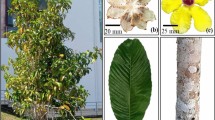Spinasterol (1) and spinasteryl acetate (2) from the leaves of Ardisia pyramidalis (Cav.) Pers. (Myrsinaceae) were tested on duck chorioallantoic membrane (CAM) vascularity assay. The petechial to severe hemorrhaging, hyperemia, and the formation of ghost vessels were observed in CAMs treated with compounds 1 and 2. Both sterols have effectively suppressed blood vessel branching and inter-capillary elongation. High degree of vonWillebrand factor expression was observed in these CAMs treated with 1 and 2. This is further confirmed by the absence of the epithelial membrane antigen in all samples tested, suggesting that the main mechanism of angio-suppression is related to the action of von Willebrand factor which modulates other angiogenic factors. Spinasterol was found to be most effective in reducing the branch point formation and inter capillary distance with very minimal incidence of mortality, thus suggesting its potential as a source of phytopharmaceuticals.





Similar content being viewed by others
References
M. A. Polinag, DENR Recommends, Vol. 12: Food from the Wilderness, Ecosystem Research and Development Bureau, Department of Environment and Natural Resources, College Laguna (2003), p. 2.
D. A. Madulid and E. M. G. Agoo, A pictorial Guide to the Noteworthy Plants of Batanes Islands, UNESCO National Commission of the Philippines Science and Technology, Commision and National Museum of the Philippines (2006), p. 87.
A. A. Herrera, R. E. C. King, and L. A. D. G. Ipulan, J. Med. Plant Res., 5, 3904 – 3916 (2011).
A. A. Herrera and E. C. Amor, J. Med. Plant Res., 5, 2637 – 2646 (2011).
S. D. Jacinto, E. F. Ramos, A. P. T. Siguan, et al., Asian J. Biol. Educ., 5, 22 – 25 (2011).
D. D. Raga, A. B. Alimboyouguen, C.-C. Shen, et al., Philipp. Agric. Sci., 94, 103 – 110 (2011).
A. A. Herrera, L. A. Ipulan, and A. D. C. Tameta, Asia Life Sci., 21, 95 – 105 (2012).
T. Leung, J. M. Miller, K. V. Bilbao, et al., Retina: J. Retin. Vitr. Dis., 24, 427 – 434 (2004).
J. D. Burdick, Y. Gao, B. Kanengiser, et al., Toxicologist, 72 (S1), 220 (2003).
K. Norby, Microvasc. Res., 55, 43 – 53 (1998).
C. Y. Ragasa and K. Lim, Philipp. J. Sci., 134, 83 – 87 (2005).
T. Itoh, Y. Kikuchi, T. Tamura, et al., Phytochemistry, 20, 761 – 764 (1981).
E. Coballase-Urrutia, J. Pedraza-Chaverri, R. Camacho-Carranza, et al., Toxicology, 276, 41 – 48 (2010).
F. C. Meotti, J. V. Ardenghi, J. B. Pretto, et al., J. Pharm. Pharmacol., 58, 107 – 112 (2006).
S. Boller, C. Soldi, M. C. Marques, et al., J. Ethnopharmacol., 130, 262 – 266 (2010).
G. S. Jeong, B. Li, D. S. Lee, et al., Int. Immunopharmacol., 10, 1587 – 1594 (2010).
Y. S. Ravikumar, K. M. Mahadevan, H. Manjunatha, et al., Phytomedicne, 17, 513 – 518 (2010).
B. Csuppor-Löffler, Z. Hajdú, I. Zupkó, et al., Planta Med., 77, 1183 – 1188 (2011).
L. C. Klein Jr., R. B. Gandolfi, J. R. Santin, et al., Arch. Pharmacol., 381, 121 – 126 (2010).
G. C. Jeon, M. S. Park, D. Y. Yoon, et al., Exp. Molec. Med., 37, 111 – 120 (2005).
S. B. Fox, R. D. Leek, J. Bliss, et al., J. Nat. Cancer Inst., 89, 1044 – 1049 (1997).
J. Huang, R. Roth, J. E. Heuser, et al., Blood, 113, 1589 – 1597 (2009).
R. D. Starke, F. Ferraro, K. E. Paschalaki, et al., Blood, 117, 1071 – 1080 (2011).
I. B. Lobov, P. C. Brooks, and R. A. Lang, Proc. Natl. Acad. Sci. USA, 99, 11205 – 11210 (2002).
Acknowledgments
The authors gratefully acknowledge the research grant from the Human Resource and Institutional Development, Philippine Council for Advanced Science and Technology, Research and Development of the Department of Science and Technology (HRIDD-PCASTRD-DOST) of the Philippines as well as the Philippine Kidney and Dialysis Foundation for the Histological processing.
Author information
Authors and Affiliations
Corresponding author
Rights and permissions
About this article
Cite this article
Raga, D.D., Herrera, A.A., Alimboyoguen, A.B. et al. Angio-Suppressive Effect of Sterols from Ardisia Pyramidalis (Cav.) Pers.. Pharm Chem J 51, 683–689 (2017). https://doi.org/10.1007/s11094-017-1674-4
Received:
Published:
Issue Date:
DOI: https://doi.org/10.1007/s11094-017-1674-4




